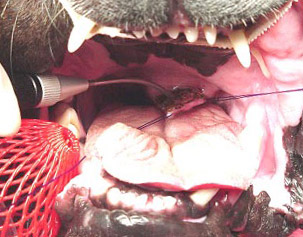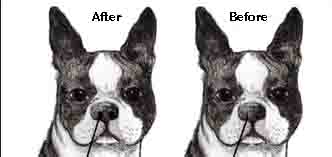Summary:
"Flat faced brachycephalic dog breeds such as bulldogs suffer from multiple medical problems due to preferences for dogs with a flatter face and pushed-in noses. One of the most prevalent problems are breathing issues referred to as brachycephalic airway syndrome. Brachycephalic airway syndrome (BAS) refers to several respiratory problems that affect the dog's mouth, throat and nose. One way to reduce or prevent breathing related problems is by keeping flat faced breeds at a healthy weight. This can ease breathing related difficulties and can help to avoid surgery in mild cases.
Early diagnosis and treatment an result in a better outcome. Most dogs have multiple breathing problems that need to be corrected. If there is only one defect, such as a narrowing of the nostrils (called stenotic nares), the better the prognosis. The prognosis for dogs under 2 is higher than for older dogs. Surgical correction can result in a much better quality of life for the dog.
Brachycephalic dogs can be prone to eye problems, dry eye, eye
irritation and eyes that appear to pop out (proptosis). They are
also prone to panting due to heat stress.

Brachycephalic Syndromes can lead to sudden death due to acute airway collapse that results from airway obstruction due to many of the issues described below (see bottom of page for free brochures on the condition)."
Brachycephalic Dog Breeds
There are several breeds that are vulnerable to BAS. This includes:
- Bull Mastiffs
- Shih Tzus
- Lhasa Apsos
- Pugs
- Pekingese
- Boston Terriers
- Boxers
- Bulldogs
Respiratory System Abnormalities
Structural abnormalities in the face and head of brachycephalic dog breeds include:
- Everted laryngeal saccules:
this is usually seen with other respiratory issues. Dogs with BAS and
labored breathing can cause small pouches to form inside the larynx
that are either sucked into the airway or turned outward.
- Hypoplastic trachea: This
refers to a narrower-than-normal windpipe. This cannot be corrected
surgically.
- Elongated soft palate: in this condition the soft part of the roof of the mouth is too long when compared to mouth length. At the back of the throat the extra soft palate tissue blocks the entrance to the windpipe (trachea). The elongated palate can be shortened to remove excess tissue in surgery.

Stenotic nares: This refers to narrow nostrils that restrict air that can enter into the nose. Air flow can be improved by using surgery to remove tissue from the nostrils.

Symptoms
Symptoms associated with Brachycephalic airway syndrome include:
- Infections in facial skin folds
- Dental problems
- Eye problems
- Hunched body posture when inhaling
- Trouble swallowing
- Susceptibility to heat stroke
- Turning blue
- Snorting
- Excessive snoring
- Collapsing after significant activity
- Fainting after rigorous activity
- Tires easily
- Vomiting
- Gagging and Choking
- Coughing
- Breathing with an open mouth
- Overheating
- Cyanosis (blue-tinged color)
- Intolerance for exercise
Diagnosis
Diagnosis of Brachycephalic Airway Syndromes is based on the dog's facial shape, physical examination, breed, and clinical symptoms. Abnormalities are diagnosed by sedation or by putting the dog under anesthesia. Note that in some cases sedation or anesthesia could be dangerous given breathing abnormalities. Tests used are a tracheoscopy or a laryngoscopy, where a fiber optic scope is inserted through the mouth into the trachea and larynx.
The condition can be diagnosed as young as age 1, and usually some time between age 1 year and 4 years.
BAS is scored on a five-point scale:
- 0 = No symptoms
- 4, 5 = Difficulty
breathing and could be life threatening
Additional tests such as blood work and X-Rays can be used to determine the health of the patient prior to initiating treatment. The veterinarian will also want to rule other other causes of breathing difficulties such as an upper respiratory infection or allergy that can cause a dog's airways to swell.
Keeping a bulldog at normal weight can reduce any breathing discomfort and relieve symptoms such as snoring and labored breathing.
Treatment
If your dog is breathing heavy, or the breathing seems labored, be sure to visit your veterinarian for a checkup. Dogs with BAS tend to have more than one breathing problem that needs to be corrected. Slimming down a bulldog or other flat-faced breed will help to reduce BAS symptoms such as snoring and labored breathing. Also consider getting a harness that does not tug at the dog's neck. Breathing problems often accompany issues such as gastric reflux, which pushes gastric fluids into the esophagus, causing additional problems.
Owners should also avoid situations that cause labored heavy dog breathing such as excessive physical exercise and stress, particularly on hot days.
Medications and Therapy
Oxygen therapy and anti-inflammatory medications are often used to bring relief to dogs. Relief is short-term with surgery being the best option for long-term relief.
Surgery
For most dogs with BAS surgery is the recommended treatment in order to correct any structural abnormalities in the throat or face. Many bulldogs require respiratory surgery where the elongated soft palate at the back of the throat is shortened, allowing the dog to breath easily. New surgical techniques such as the use of lasers can reduce recovery times and result in lower levels of bleeding and swelling.

Post surgery brachycephalic dog breeds will need to be monitored closely since the surgery can cause airway swelling, resulting in an even narrower air passage until the swelling subsides. In some patients it may be necessary for a veterinarian to use a nasotracheal catheter where a tube is passed into the trachea via the nasal passage. In chronic cases, a dog will require a tracheotomy, which is a procedure where an incision is made in the dog's wind pipe.
Post surgery medications can help to reduce any pain and antibiotics are administered if there is a risk of infection. Dogs will need to return to the veterinarian for two weeks after surgery and exercise might be restricted over this time.
Cost of Surgery
The cost of surgery for brachycephalic dog breeds runs between $500 and $3,000 (U.S. dollars) depending on the extend and number of breathing problems that need to be corrected.
Prognosis
Brachycephalic dog breeds that undergo surgery and that are under age 2 have the best prognosis. Having fewer defects that need to be corrected also results in a better prognosis (e.g;; 1 defect has a better prognosis than 2).
Many dogs can experience a significantly better quality of life after surgery.
For Additional Research:
American College of Veterinary Surgeons
Brochures for Download on Brachycephalic Airway Syndrome:
Ask Our Vet A Question And We Will Answer It For Free
Have A Question about Dog Breathing Problems for Our Vet?
Do you have a question or comment on a dog breathing problem such as Brachycephalic Airway Syndrome (BAS) or heavy breathing and panting? Share it!
Our Veterinarian will answer questions for FREE, plus you will be helping other dog owners that will see the question and our response. Please include your dog's age, breed, sex, medical history, medications, changes in behavior and if possible, a picture of the condition.
Please do not type your question in all capital letters.
We will do our best to get back to you quickly (it depends on how many questions we receive each day). If you do require an immediate response we suggest using this online dog veterinary service that is available now and operates 24 hours a day.
Other Reader Dog Respiratory Related Questions and Vet Suggestions
Click below to see contributions from other visitors to this page...
Causes of Dog Snoring and Snorting Not rated yet
Reader Question: Why hasn't surgery corrected my dog's snoring and snorting problem?
My dog had his an everted saccules. The veterinarian removed …
Still Hear the Soft Palate After Dog Surgery Not rated yet
Reader Question: Dog Soft Palate Snoring and Snorting After Surgery
My dog had his everted saccules removed and a small amount of the soft palate …
